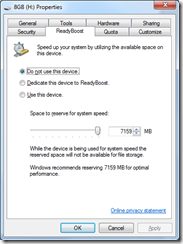ReadyBoost Changes in Windows 7
ReadyBoost is a feature that was introduced in Windows Vista, allowing a flash memory device (such as a USB flash drive or SD card) to act as a memory cache. This assisted with increasing a PC's performance, especially when physical memory was limited or not upgradable.
Windows 7 has improved the capabilities of ReadyBoost over Windows Vista, including:
- Maximum cache size has been increased from 4GB to 32GB. Note that to utilize a memory cache of greater than 4GB, the flash drive needs to be formatted with either a exFAT or NTFS file system.
- Support for up to 8 ReadyBoost devices simultaneously on the PC. Windows Vista only supported a single ReadyBoost device per PC.
- The ReadyBoost cache can be used during boot to improve startup performance.
The ReadyBoost UI itself hasn't really changed in Windows 7, other than an added option to dedicate the device to ReadyBoost. In Windows Vista, there were only two options – use or don't use the device for ReadyBoost.
Of course, it still holds true the the best option, if possible, is to upgrade the physical RAM to increase system performance. However, when this isn't an option or if you have some extra space on a flash drive that you are not using, ReadyBoost is there as an alternative. A prime example of where ReadyBoost shines are Windows 7 netbooks that only have 1GB of RAM installed. Having a ReadyBoost cache of 2-4 GB will have a noticeable effect on system performance.
Note that if you are using a Solid State Drive (SSD) in your PC, you will likely not have the option to use ReadyBoost when inserting a flash memory device. This is because in general, SSD drives are fast enough so that there would be no benefit in using a ReadyBoost device over the SSD.
Resources
- https://www.microsoft.com/windows/windows-vista/features/readyboost.aspx
- https://windows.microsoft.com/en-US/windows7/products/features/readyboost
Comments
- Anonymous
August 18, 2010
Even with a Solid State Drive (SSD) the option is there. I think if you have enough memory on your system, ReadyBoost is not going to shine. Potentially, you may experience worse performance.
